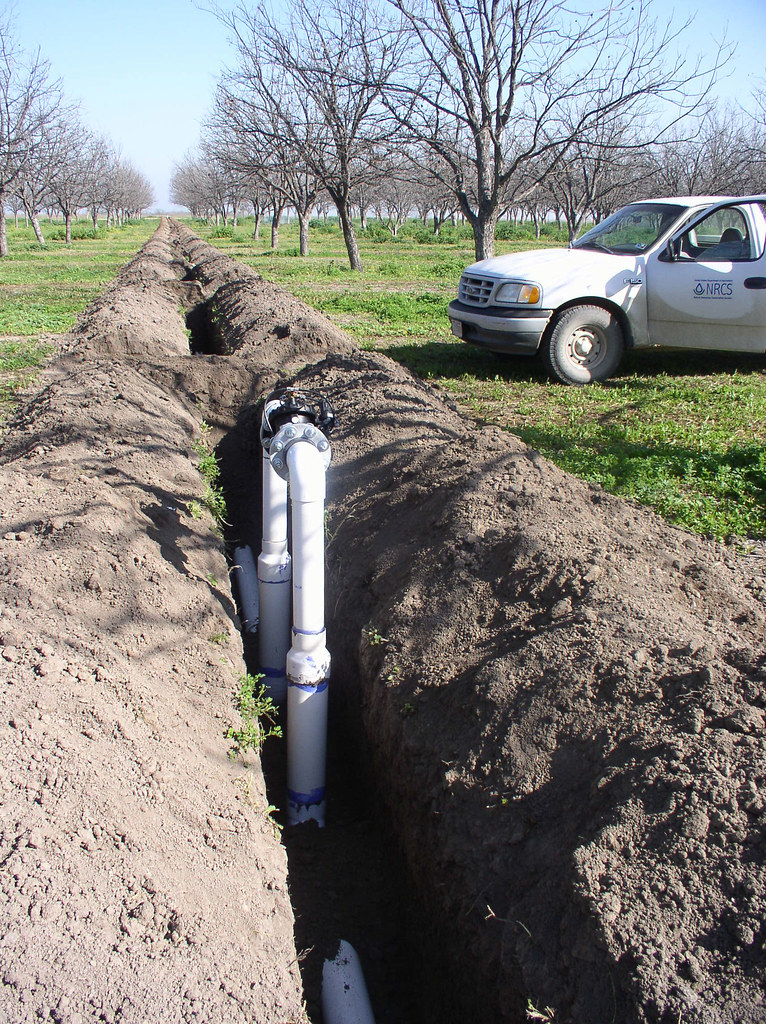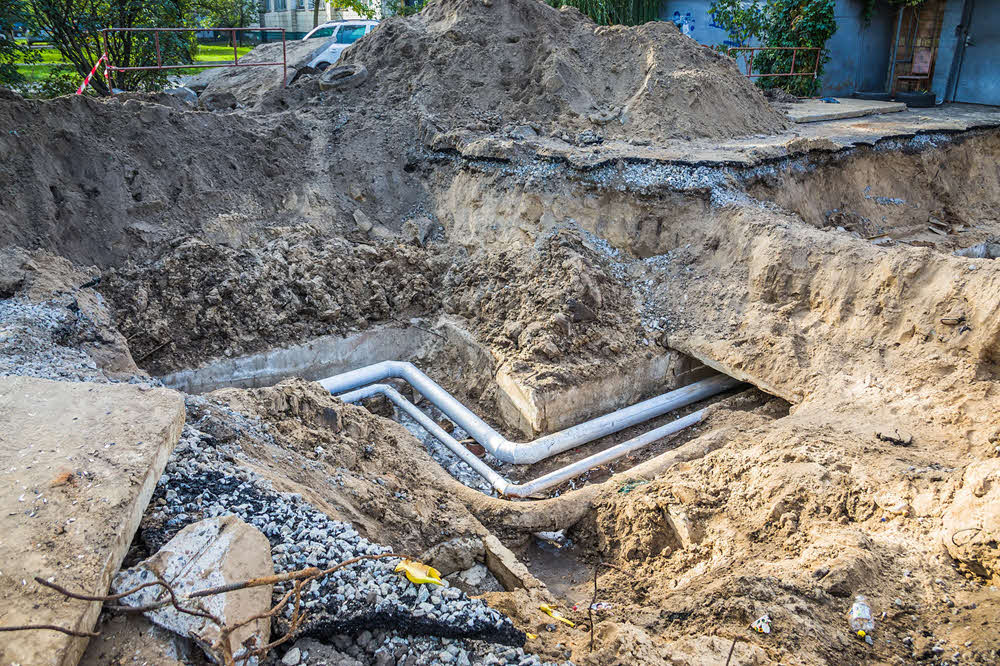Trenching Water Line Servicesin Clay Township MI
Trenching for Water Lines to Ensure Reliable Water Flow
We Are Locally Owned & Operated For Over 37 Years
Contact Us Today!
We Serve Businesses In And Around The Following Cities:
About Trenching Water Line Services
Trench for Water Line in Clay Township: A Comprehensive Guide for Commercial Property Owners
Clay Township, a vibrant commercial hub, is known for its diligent maintenance and development of its water infrastructure. In this bustling city lies a considerable number of commercial establishments that rely on a sustainable water supply system for their operations. The foundation of this system is often unheard of, but indisputably crucial—trenching for a water line. Understanding this process, its applications, and the benefits it can bring to your commercial property can ensure the smooth and efficient running of your business.
Unraveling the Process of Trenching for a Water Line
The process of trenching for a water line is a fundamental aspect of water main installation, and, despite being unseen in the final output, it holds the key to your property’s water supply efficiency. It all starts with a detailed survey of the site to determine the optimal path for the water line. This step requires expert hands and intelligent use of underground line detection devices to prevent damaging existing infrastructures.
Once the preparatory work is done, excavation begins. The trench dimensions may vary depending on the expanse of the property and future volume of water required. The aim is to provide an adequately deep and wide path that allows the water service line to be safely housed. Grading the bottom of the trench to create a gentle slope is essential for water flow, as gravity helps direct water towards the service point.
The next step is the actual water line installation, a crucial process where pipes are laid down in trenches and connected. Post-installation steps involve backfilling the trench, compacting the soil, and finally, restoring any disrupted landscapes. Quality control checks throughout the process ensure the durability and longevity of the system.
Benefits of Efficient Trenching for Water Line
Efficiently trenching for a water line offers more than simply following the necessary steps for water supply implementation. Done well, it sets the stage for a reliable and robust water supply system that is pivotal for commercial properties. Commercial establishments need an efficient water system to function optimally, whether it’s to maintain sanitation or to aid in operational processes.
When the trench is dug professionally, with foresight and consideration for the property’s layout and usage now and in the future, the water line is less susceptible to external disturbances. This decreases the likelihood of time-consuming and costly repairs. Being proactive in ensuring a good-quality water line installation offers a considerable return on investment in the long run.
Real-World Applications in Commercial Properties
Consider a bustling restaurant in the heart of Clay Township. A professionally installed water line, beginning with a well-dug trench, ensures a trouble-free service. It aids in everything from key operational processes, such as dishwashing and cooking, to maintaining customer amenities. Any disruption in the water line could lead to significant operational troubles and losses.
Another example could be a large office building. Depending on the number of employees and the nature of the work, the demand for water can vary. Efficient trenching and water line installation allow for a versatile system that caters to such dynamic needs, which is paramount for businesses to run smoothly.
How to Achieve an Effective Trench for Water Line
Accomplishing an effective trench for a water line demands more than everyday labor—it calls for expert hands. Companies such as D&J Contracting boast a successful track record in delivering such intricate tasks with commendable professionalism. Their experience and expertise in similar projects throughout Clay Township positions them as a trusted partner in ensuring your business’s water supply requirements are met efficiently.
Tasks like trenching for a water line require not only impeccable execution but also careful planning. Partnering with service providers like D&J Contracting, who bear local knowledge and a reputable service record, ensures you tap into a reservoir of insights and recommendations perfected over time.
Ultimately, the success of running a new water line lies in the hands of the professionals contracted to do the job. Ensuring you make the best choice here will inevitably reflect on your commercial property’s functionality and success.
As Clay Township continues to thrive and develop, ensuring your commercial property’s efficient water supply system lays the foundation for smooth and uninterrupted business operations. But the process isn’t just about digging a trench and laying the pipe—it involves careful planning, precise execution, and diligent maintenance. By understanding this, one can harness the full potential of a professionally installed and quality-controlled water line system, leading to sustainable success in the long term.
Trenching Water Line Services Gallery


Call Us Today to receive your Free Quote for
Trench For Water Line in Clay Township
Serving: Clay Township, Michigan

About Clay Township, Michigan
The area was first settled by John Martin in 1805, and the area was originally referred to as Pointe du Chene (Oak Point). In 1826, the area was organized as Plainfield Township, which was named by early settler John K. Smith after his hometown of Plainfield, Vermont. A post office named Plainfield began operating here on April 5, 1826 with Smith serving as the first postmaster. In 1828, the township was reorganized and renamed after attorney and statesman Henry Clay, and the post office was later renamed Clay on December 23, 1835; Smith continued serving as postmaster. The post office was renamed Algonac on August 17, 1843. Algonac incorporated as a village within Clay Township in 1867. The village gained autonomy from the township when it incorporated as a city in 1967.
- Colony Tower Complex
- Harsen House
- LeRoy Smith House
- North Channel Shooting Club
- St. Clair River Informational Designation
- Stewart Farm / Memoir of Aura Stewart
- St. Clair Flats Front and Rear Range Light
According to the U.S. Census Bureau, the township has a total area of 82.47 square miles (213.60 km), of which 35.32 square miles (91.48 km) is land and 47.15 square miles (122.12 km) (57.17%) is water.
The township contains a large portion of water that includes areas along the St. Clair River mouth in the northern Anchor Bay area of Lake St. Clair, which contains numerous channels and canals. Directly across the river is the Walpole Island First Nation in Ontario, which is accessible via the Walpole–Algonac Ferry in downtown Algonac.
The St. Clair Flats State Wildlife Area and the majority of the St. John’s Marsh State Wildlife Area are located within Clay Township. Most of Algonac State Park is located within Clay Township with a small portion extending north into Cottrellville Township.
- Bedore is an unincorporated community located along the southern coast of Harsens Island at 42°33′28″N 82°36′47″W / 42.5578126°N 82.6129630°W.
- Clays Landing is an unincorporated community located at the southern terminus of M-154 on Harsens Island at 42°33′06″N 82°36′16″W / 42.5517016°N 82.6043512°W.
- Forster is an unincorporated community located just west of Bedore at 42°33′40″N 82°37′06″W / 42.5611459°N 82.6182410°W.
- Grand Pointe is an unincorporated community located in the northeastern area of Harsens Island at 42°35′58″N 82°32′43″W / 42.5994788°N 82.5451844°W. The affluent community was settled as early as 1888 by the Grand Pointe Improvement Company, and a post office operated briefly from October 16, 1889 until January 5, 1892.
- Harsens Island is the name of the post office that serves the island and several surrounding islands. Harsens Island was first settled as early as 1779 by James Harsen, who was the area’s first white settler. By 1783, Harsen had purchased the entire island from its native Indian population. As late as 1809, the island was also known as James (also Jacob or Jacobus) Island. The post office began operating under the name Sans Souci on April 24, 1900 and was renamed Harsens Island on December 31, 1960. The post office uses the 48028 ZIP Code.
- Maple Leaf is an unincorporated community located on Harsens Island just southwest of the community of Sans Souci at 42°34′41″N 82°34′11″W / 42.5780902°N 82.5696288°W.
- Miller is an unincorporated community located near the southernmost end of Harsens Island at the end of public road access at 42°32′57″N 82°39′32″W / 42.5492017°N 82.6587976°W.
- Muirs is an unincorporated community located along M-154 on Harsens Island at 42°33′23″N 82°35′14″W / 42.5564238°N 82.5871285°W.
- Pearl Beach is an unincorporated community and census-designated place (CDP) located along the southern end of the mainland at 42°37′36″N 82°35′52″W / 42.6267006°N 82.5976876°W.
- Perch Point is an unincorporated community located along M-29 in the northwestern portion of the township along the border with Ira Township at 42°39′54″N 82°37′13″W / 42.6650333°N 82.6201900°W.
- Pointe aux Tremble is an unincorporated community located along M-29 within the Pearl Beach CDP at 42°37′17″N 82°34′16″W / 42.6214230°N 82.5710196°W. The community was settled in 1904 as a station along the railway about 3.0 miles (4.8 km) west of Algonac.
- Riverside is an unincorporated community located in the southern portion of Harsens Island at 42°33′32″N 82°37′49″W / 42.5589237°N 82.6301859°W.
- Roberts Landing is an unincorporated community located along M-29 near Algonac State Park along the border with Cottrellville Township at 42°39′35″N 82°30′57″W / 42.6597561°N 82.5157415°W. The community was named after its first settler, who arrived here in 1830. The Roberts family settled the area as a popular fishing and hunting destination. A post office operated here from April 29, 1869 until December 15, 1895.
- Sans Souci is an unincorporated community located on Harsens Island at 42°34′52″N 82°33′44″W / 42.5811490°N 82.5621580°W.
As of the census of 2000, there were 9,822 people, 3,934 households, and 2,844 families residing in the township. The population density was 277.0 inhabitants per square mile (107.0/km). There were 5,325 housing units at an average density of 150.2 per square mile (58.0/km). The racial makeup of the township was 97.92% White, 0.20% African American, 0.68% Native American, 0.11% Asian, 0.21% from other races, and 0.87% from two or more races. Hispanic or Latino of any race were 0.85% of the population.
There were 3,934 households, out of which 27.9% had children under the age of 18 living with them, 61.3% were married couples living together, 7.0% had a female householder with no husband present, and 27.7% were non-families. 22.9% of all households were made up of individuals, and 9.2% had someone living alone who was 65 years of age or older. The average household size was 2.50 and the average family size was 2.94.
In the township the population was spread out, with 22.6% under the age of 18, 6.5% from 18 to 24, 28.2% from 25 to 44, 28.8% from 45 to 64, and 13.9% who were 65 years of age or older. The median age was 41 years. For every 100 females, there were 103.6 males. For every 100 females age 18 and over, there were 103.2 males.
The median income for a household in the township was $55,059, and the median income for a family was $63,182. Males had a median income of $48,053 versus $31,923 for females. The per capita income for the township was $27,169. About 2.3% of families and 4.7% of the population were below the poverty line, including 6.7% of those under age 18 and 3.6% of those age 65 or over.
Call Us Today to receive your Free Quote for
Trench For Water Line in Clay Township
Related Services in Clay Township, Michigan
We Serve Businesses In The Following Zip Codes:
48007, 48015, 48021, 48026, 48035, 48036, 48038, 48042, 48043, 48044, 48045, 48046, 48047, 48048, 48050, 48051, 48066, 48071, 48080, 48081, 48082, 48083, 48084, 48085, 48088, 48089, 48090, 48091, 48092, 48093, 48098, 48099, 48225, 48230, 48236, 48310, 48311, 48312, 48313, 48314, 48315, 48316, 48317, 48318, 48397